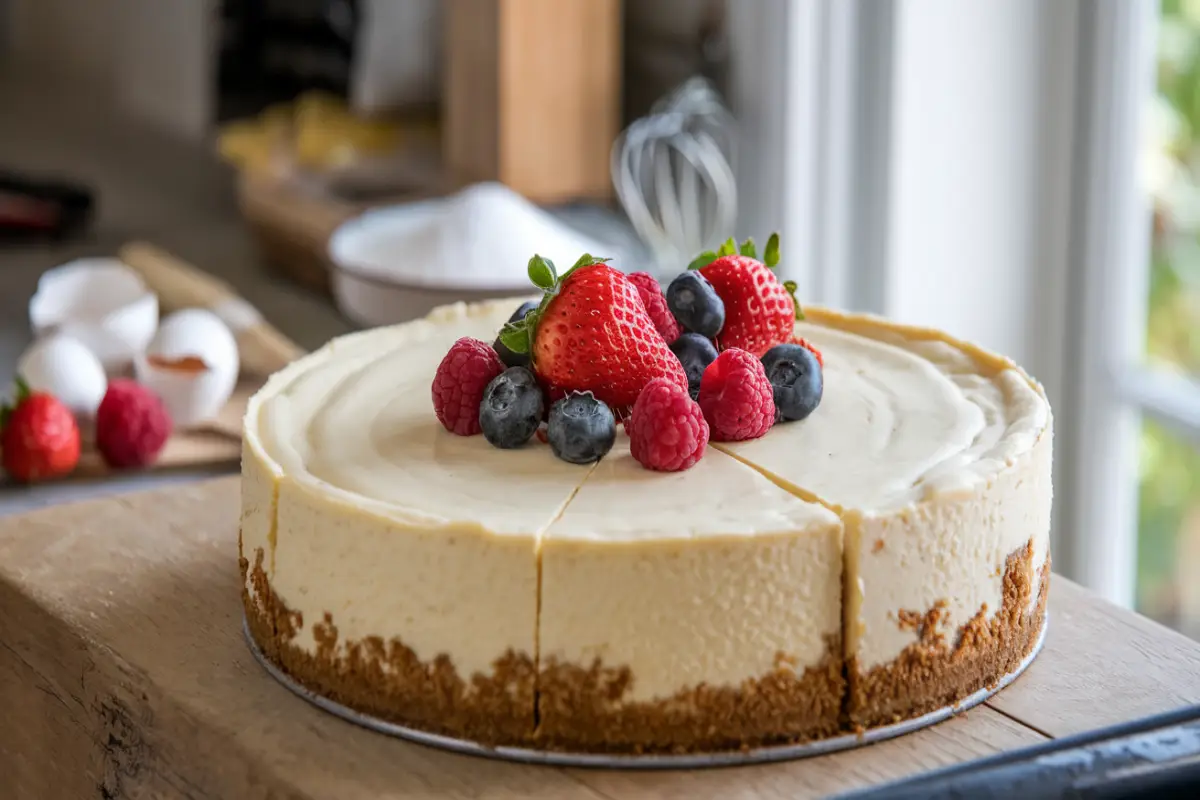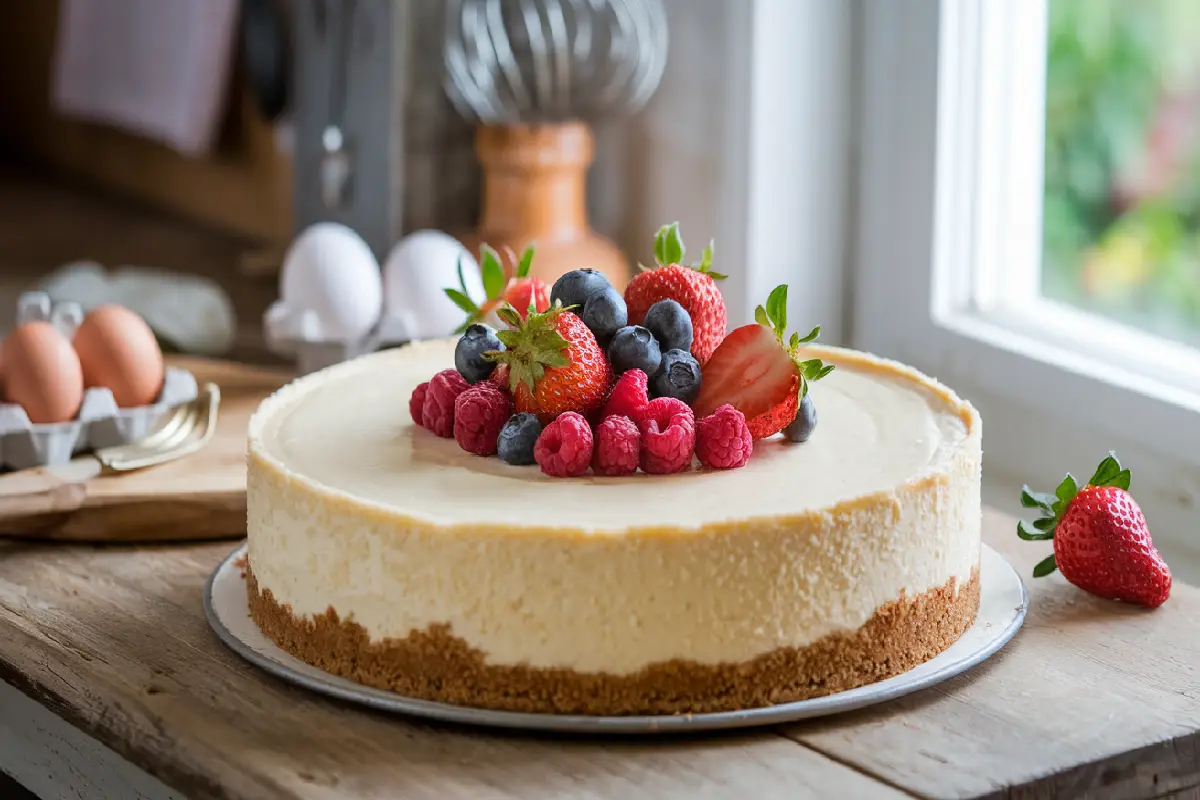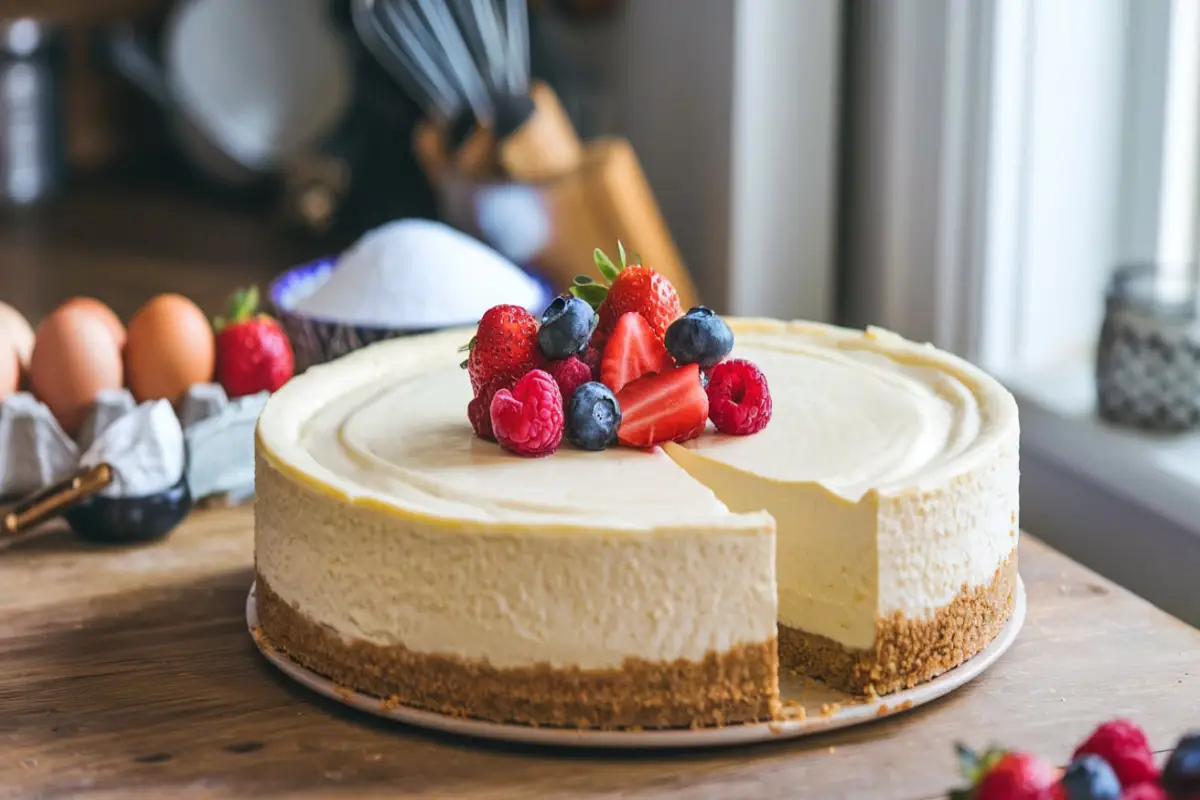Introduction: Philadelphia Cheesecake Recipe
The Philadelphia Cheesecake Recipe is a cherished dessert, renowned for its creamy and velvety texture. This comprehensive guide will lead you through each stage of crafting the perfect cheesecake, from gathering your ingredients to offering serving suggestions. Whether you’re an experienced baker or just starting out, this recipe is designed to be straightforward and easy to master. Along the way, we’ll delve deeper into tips, variations, and insights to ensure your cheesecake turns out flawlessly every time.
Ingredient Breakdown
Before you begin, it’s essential to collect all the necessary ingredients. The quality of what you use will significantly impact the final outcome of your cheesecake.
Core Ingredients: Philadelphia Cheesecake Recipe
- 1 ½ cups graham cracker crumbs
- ¼ cup melted butter
- 3 tablespoons sugar (for the crust)
- 4 (8-ounce) packages of Philadelphia cream cheese, softened
- 1 cup sugar
- 1 teaspoon vanilla extract
- 4 large eggs
Understanding the Ingredients: Philadelphia Cheesecake Recipe

Philadelphia Cream Cheese
The hallmark of this cheesecake is the rich and creamy texture provided by Philadelphia cream cheese. Ensuring the cream cheese is at room temperature before mixing helps prevent lumps in your batter, resulting in a smooth finish. This texture is what differentiates a Philadelphia Cheesecake from others.
Graham Cracker Crumbs
The crust serves as the foundation of your cheesecake. Graham cracker crumbs create a sturdy, slightly sweet base that complements the creamy filling perfectly. If you’re looking for a different flavor, consider substituting with digestive biscuits or even chocolate cookies. The crumbs are mixed with melted butter to form a crust that holds up well under the filling.
Sugar and Vanilla Extract
Sugar is crucial for balancing the tanginess of the cream cheese, while vanilla extract adds a delightful aroma and flavor. You can experiment with different extracts, such as almond or lemon, to give your cheesecake a unique twist.
Eggs
Eggs act as the binding agent, providing structure to the cheesecake. Adding eggs one at a time and mixing them on low speed prevents overmixing, which can introduce too much air into the batter, leading to cracks during baking.
Philadelphia Cheesecake Recipe: Ingredient Substitutions
For a healthier version, you can replace regular cream cheese with low-fat cream cheese, though this may slightly affect the texture, making it less creamy. If you need a gluten-free option, use gluten-free graham crackers or digestive biscuits instead of regular ones.
Optional Additions
If you’re feeling adventurous, you can add a tablespoon of lemon juice to the filling for a hint of tang or mix in chocolate chips for added richness. A pinch of salt in the crust mixture can also enhance the overall flavor of the cheesecake.
Detailed Preparation Steps: Philadelphia Cheesecake Recipe
With your ingredients ready, it’s time to get started on making your Philadelphia Cheesecake. Following these steps will help ensure your cheesecake is smooth, creamy, and free of cracks.
Creating the Crust
- Preheat your oven to 325°F (165°C). This temperature is ideal for baking a cheesecake without causing it to brown too quickly or develop cracks.
- Combine the graham cracker crumbs, melted butter, and 3 tablespoons of sugar until well mixed. The mixture should resemble wet sand and stick together when pressed.
- Firmly press the mixture into the bottom of a 9-inch springform pan, forming the base of your cheesecake. Use the back of a spoon or the bottom of a glass to ensure an even layer.
- Bake the crust for about 10 minutes, then let it cool. This step helps set the crust, providing a sturdy foundation for the filling.
Tip: If you prefer a thicker crust, press the mixture slightly up the sides of the pan.
Preparing the Cheesecake Filling
- Beat the Philadelphia cream cheese in a large mixing bowl until it’s smooth. This step is crucial for a lump-free filling, which is key to achieving a smooth cheesecake.
- Gradually add the sugar and vanilla extract, mixing until fully incorporated. The sugar dissolves into the cream cheese, creating a sweet and smooth base.
- Add the eggs one at a time, mixing on low speed after each addition until just combined. This prevents overmixing, which can lead to cracks in your cheesecake.
- Pour the filling over the cooled crust. Use a spatula to smooth the top.
Baking the Cheesecake
- Bake the cheesecake in the preheated oven for 45-55 minutes, or until the center is almost set. The center should still have a slight jiggle when gently shaken.
- Check for doneness by gently shaking the pan; the center should move slightly, much like set gelatin.
- Loosen the cake from the pan by running a knife around the edge. This prevents the cheesecake from sticking to the sides and cracking as it cools.
Important: If you’re using a dark nonstick springform pan, reduce the oven temperature to 300°F (150°C) to avoid overbrowning.
Cooling and Setting the Cheesecake
- Allow the cheesecake to cool completely on a wire rack. Gradual cooling at room temperature helps prevent cracks. A sudden drop in temperature can cause the cheesecake to crack.
- Refrigerate the cheesecake for at least 4 hours once it’s cooled. This helps the cheesecake firm up and develop its flavors. For the best results, chill it overnight.
Tip: Run a thin knife around the edge of the cheesecake before removing the sides of the springform pan to ensure a clean finish.
Cheesecake Variations
One of the joys of cheesecake is its versatility. Below are some popular variations and customization ideas to suit your taste or the occasion.
Flavored Cheesecakes
- Lemon Cheesecake: Incorporate the zest and juice of one lemon into the cream cheese mixture for a refreshing citrus flavor.
- Chocolate Cheesecake: Melt 4 ounces of semisweet chocolate and blend it into the cream cheese mixture before adding the eggs.
- Berry Swirl Cheesecake: Swirl in 1/2 cup of berry puree, such as raspberry or strawberry, into the batter before baking.
Toppings
- Fresh Berries: Adorn your cheesecake with a variety of fresh berries like raspberries, blueberries, or strawberries for a burst of flavor.
- Whipped Cream: Add a dollop of homemade whipped cream to each slice for an extra indulgence.
- Caramel Sauce: Drizzle caramel sauce over the cheesecake for a rich and sweet finishing touch.
Mini Cheesecakes
For a fun alternative, consider making mini cheesecakes. Use a muffin tin lined with paper liners, pressing a small amount of the crust mixture into each liner and filling with the cheesecake batter. Bake at 325°F (165°C) for 20-25 minutes or until set. These are perfect for parties or portion control.
You can also experiment with adapting this recipe into different formats, such as bars or layering it with other desserts like brownies.
Philadelphia Cheesecake Recipe: Common Pitfalls and How to Avoid Them

Even seasoned bakers can encounter challenges when making cheesecake. Here’s how to avoid the most common mistakes:
Overbaking
Overbaking often results in a dry, cracked cheesecake. To avoid this, remove the cheesecake from the oven when the center is still slightly jiggly. It will continue to set as it cools.
Cracking
Cracks in the cheesecake can occur if too much air is incorporated into the batter or if it’s overbaked. To prevent this, mix the ingredients on low speed and resist the urge to open the oven door during baking. A water bath can also help maintain even baking temperatures, reducing the likelihood of cracks.
Tip: If your cheesecake does crack, don’t worry! You can easily cover it with a layer of sour cream or whipped cream.
Cooling Too Quickly
Allowing the cheesecake to cool too rapidly can also cause it to crack. After baking, turn off the oven and crack the oven door open, letting the cheesecake cool inside for about an hour before moving it to a wire rack to cool completely.
Learn more about Perfect Cheesecake Baking Techniques to ensure your cheesecake turns out flawless every time.
Serving Ideas: Philadelphia Cheesecake Recipe
The way you serve your cheesecake can enhance the overall experience. Here are some suggestions:
Presentation
Place your cheesecake on a decorative cake stand to create an eye-catching presentation. A beautifully presented cheesecake can be the star of any dessert table.
Pairings
Cheesecake pairs wonderfully with a variety of beverages. Serve it with a cup of coffee for a classic combination, or try a glass of dessert wine like late-harvest Riesling or Moscato. Seasonal fruits can also provide a fresh contrast to the rich cheesecake.
Seasonal Twists
Add a layer of pumpkin puree to the filling for an autumn-inspired variation. In summer, top your cheesecake with fresh berries or a citrus glaze. During the winter holidays, drizzle it with chocolate or caramel sauce for an indulgent treat.
Storing and Freezing Cheesecake
Cheesecake stores exceptionally well, making it an ideal make-ahead dessert.
Storing
Store your cheesecake in the refrigerator, covered, for up to 5 days. To prevent it from absorbing any odors, wrap it tightly in plastic wrap or keep it in an airtight container.
Freezing
To freeze, wrap the cheesecake in plastic wrap and then in aluminum foil. It can be frozen for up to 2 months. When ready to serve, thaw the cheesecake in the refrigerator overnight. Once thawed, it will taste just as fresh as when it was made.
For more detailed storage instructions, refer to Storing and Freezing Desserts.
Reheating
If you prefer warm cheesecake, reheat individual slices in the microwave for about 15 seconds. This softens the texture slightly and can enhance the flavor, especially when served with a cold topping like whipped cream or ice cream.
FAQs about Philadelphia Cheesecake Recipe
How can I prevent my cheesecake from cracking?
Mix the ingredients on low speed to avoid incorporating too much air, which can cause cracking. Baking the cheesecake in a water bath can also help maintain even temperatures, reducing the risk of cracks.
Can I make Philadelphia cheesecake recipe without a springform pan?
Yes, a regular cake pan lined with parchment paper can be used for easy removal. However, a springform pan is recommended for the best results, as it allows for easy removal and a cleaner presentation.
How long does cheesecake last in the fridge?
Cheesecake can be stored in the fridge for up to 5 days if properly covered. To maintain its freshness, store it in an airtight container or wrap it tightly in plastic wrap.
Is it possible to make a no-bake version?
Absolutely! Use gelatin to set the cheesecake instead of baking. A no-bake cheesecake is quicker to make and can be just as delicious. The key is to ensure the gelatin is fully dissolved and evenly mixed into the batter.
Final Thoughts about Philadelphia Cheesecake Recipe

Philadelphia Cheesecake is a classic dessert that is as enjoyable to make as it is to eat. With the tips and tricks provided in this guide, you’re well on your way to baking the perfect cheesecake. Whether you stick to the classic recipe or try out some variations, this cheesecake is sure to be a hit at any gathering.
We encourage you to try this Philadelphia Cheesecake recipe and share your results. Happy baking!

